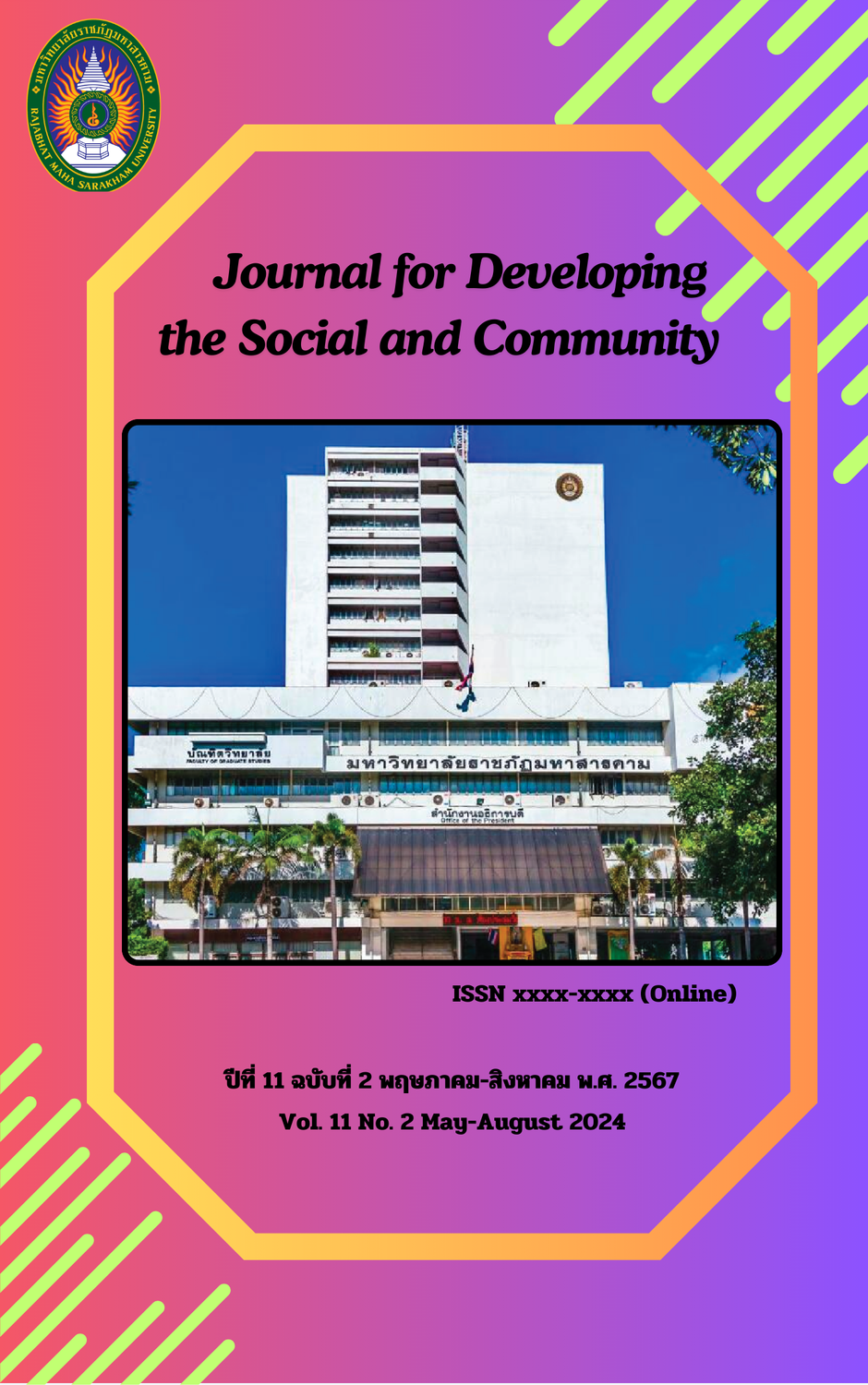A study of Representation and Mathematical Problem Solving for Mathayomsuksa I students
Keywords:
Representation, Mathematical problem solvingAbstract
The purposes of this study were to (1) study the representation of Mathayomsuksa 1 students, (2) study the mathematical problem solving of Mathayomsuksa 1 students, (3) study the relation between the representation and Mathematical problems solving for Mathayomsuksa 1 students. With a purposive sampling, purposive sampling were 80 students from the seven grade class had two classes was 1/6 and 1/8, Sarakham Pittayakhom School, Mueang Maha Sarakham, Maha Sarakham province, Under the jurisdiction of the Secondary Educational Service Area Office 26. Research tools were a representation test, a mathematical problem solving test, and an interview form of solving mathematical problems. Statistics for research were percentage, average, standard deviation, pearson correlation coefficient and a case study method. Data were presented through descriptive analysis. The results of the study were as follow: (1) the level of representation of most Mathayomsuksa 1 students was at a moderate level, representing 52.50 percent, followed by a low level, it is 33.75 percent and is at a high level, represented as 13.75 percent (2) The mathematical problem solving of the Mathayomsuksa 1 students mostly at mathematical problem solving is in fairly level, representing 38.75 percent, and (3) the relation between representation and mathematical problem solving is a high level. With a correlation coefficient of .814 and from the interviews, it was found that students at a high level be confident in answering questions and solving problems in a sequential and logical manner. Students who are in the middle level Have some confidence in answering questions. Problems are solved sequentially and logically but cannot explain thinking and problem solving. students at a low level Lack of confidence in answering questions There is no sequential and logical solution to the problem. Some people know how to solve problems but cannot use computational thinking skills to solve them.The purposes of this study were to (1) study the representation of Mathayomsuksa 1 students, (2) study the mathematical problem solving of Mathayomsuksa 1 students, (3) study the relation between the representation and Mathematical problems solving for Mathayomsuksa 1 students. With a purposive sampling, purposive sampling were 80 students from the seven grade class had two classes was 1/6 and 1/8, Sarakham Pittayakhom School, Mueang Maha Sarakham, Maha Sarakham province, Under the jurisdiction of the Secondary Educational Service Area Office 26. Research tools were a representation test, a mathematical problem solving test, and an interview form of solving mathematical problems. Statistics for research were percentage, average, standard deviation, pearson correlation coefficient and a case study method. Data were presented through descriptive analysis. The results of the study were as follow: (1) the level of representation of most Mathayomsuksa 1 students was at a moderate level, representing 52.50 percent, followed by a low level, it is 33.75 percent and is at a high level, represented as 13.75 percent (2) The mathematical problem solving of the Mathayomsuksa 1 students mostly at mathematical problem solving is in fairly level, representing 38.75 percent, and (3) the relation between representation and mathematical problem solving is a high level. With a correlation coefficient of .814 and from the interviews, it was found that students at a high level be confident in answering questions and solving problems in a sequential and logical manner. Students who are in the middle level Have some confidence in answering questions. Problems are solved sequentially and logically but cannot explain thinking and problem solving. students at a low level Lack of confidence in answering questions There is no sequential and logical solution to the problem. Some people know how to solve problems but cannot use computational thinking skills to solve them.
References
Angkanaphatkhajorn. W. (2012). Complete set of things that mathematics teachers should know: Teaching curriculum and research. Bangkok: Charansanitwong Publishing.
Ballew, H. and Cunningham, J., W. (1982). Diagnosing strengths and weaknesses of sixth- grade students in solving word problems. Journal for research in mathematics education.
Banthatthiang, J. (2004). Results of using activity points that promote mathematical skills/ processes. Regarding the use of agents, ranking pairs and graphs For Mathayom1 students. Master of Education Thesis (Secondary Education). Bangkok: Srinakharinwirot University.
Bellard, A. (2000). Student Use of Multiple Representations in Mathematical Problem Solving. Dissertation Abstracts International.
Clyde, Corle G. (1967). Teacher Mathematics in the Elementary School. New York: Ronald.
Fisher, R. (1987). Problem solving in Pimary school. Great Britain: Basil Blackwell.
Herman, D. (2003). Stories as a tool for thinking. Narrative theory and the cognitive sciences. Center for the Study of Language and Information.
Institute for the Promotion of Teaching Science and Technology. (2007). Mathematics skills/processes. Bangkok: Teacher Printing House Ladprao.
Lester, F.K. (1977). Ideas about Problem Solving: A Look at Some Psychological Research. Arithmetic Teacher.
Monsuphap. S. (2005). Creating exercises to analyze fraction problems by using representations. For Mathayom 1 students with low academic performance. Master of Education Thesis. Srinakharinwirot University.
Naoyenphon, P. (2011). Compilation of subject matter for organizing learning experiences in mathematics. Nonthaburi: Sukhothai Thammathirat Open University Press.
Phubunterm, O. (2007). A study of the ability to solve mathematical problems regarding equation problems of Mathayom 1 students by using representations. Master of Education Thesis (Secondary Education). Bangkok: Srinakharinwirot University.
Thongsu. K. (2002). Development of an investigative mathematics activity set. To promote the use of representation on systems of linear equations Mathayom 3 level. Master of Education Thesis (Secondary Education). Bangkok: Srinakharinwirot University.
Will, W. (2011). Algebraic Thinking: A Problem Solving Approach. Shaping the future of mathematics education: Proceedings of the 33rd annual conference of the Mathematics Education Research Group of Australasia.
Downloads
Published
How to Cite
Issue
Section
License
Copyright (c) 2024 Journal for Developing the Social and Community

This work is licensed under a Creative Commons Attribution-NonCommercial-NoDerivatives 4.0 International License.
Articles that are published are copyrighted by the authors of the articles







